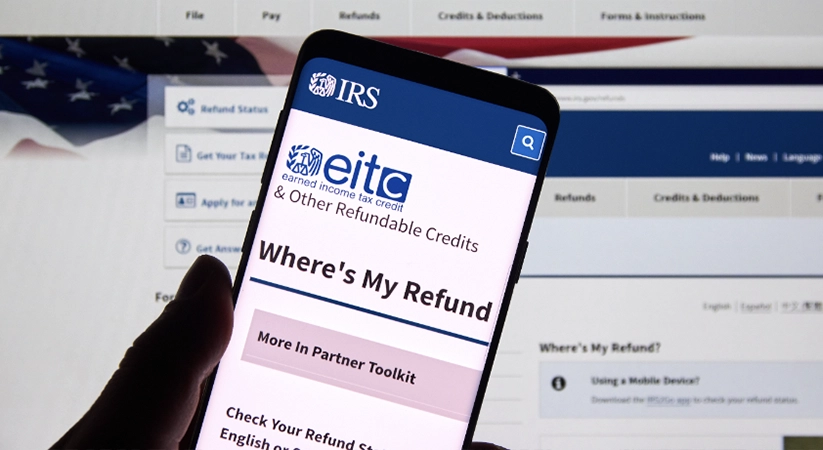
The IRS has deadlines, too?
What’s the EITC Refund Schedule?
The Earned Income Tax Credit (EITC) is a tax credit for lower-income working families, and it is designed to help them make ends meet. The EITC could provide a refund for individuals depending on factors such as their income and family size. Since the IRS processes and distributes tax refunds, the refund schedule depends on their procedures for that year.
If you are eligible for an EITC refund, you will be pleased to know that the IRS will process your refund within 21 days, provided you e-filed your return and opted for direct deposit. Usually, that will happen by the middle of February. However, it is important to remember that the IRS cannot issue refunds, including the EITC and the ACTC, before mid-February due to legislation passed in 2015.
Eligibility Requirements
To qualify for the Earned Income Tax Credit (EITC), you must meet certain eligibility requirements. The requirements include having earned income below certain limits, filing a tax return, having a valid Social Security number, and meeting the status requirements for your filing status.
Income Limits
To qualify for this tax credit, it is necessary to meet certain income limits set by the Internal Revenue Service (IRS). The income limits for the EITC are based on your filing status, number of qualifying children, and the tax year.
Both earned income and adjusted gross income must be below a certain amount to qualify for the EITC. The income limits are adjusted annually for inflation and are generally higher for taxpayers with more qualifying children.
Filing Status Requirements
When it comes to claiming the Earned Income Tax Credit (EITC), the filing status you choose can have a significant impact on your eligibility and the amount of your refund. Here are the different filing status options that qualify for the EITC refund, along with special rules and considerations that apply:
- Single or Head of Household: Taxpayers with no children can claim the EITC if they are unmarried and not filing as a dependent. To be eligible, you must also have earned income and meet the income limits. For 2023, that means adjusted gross income (AGI) of less than $17,640 for single filers and $19,680 for head of household filers.
- Married Filing Jointly: Married couples with a combined income that falls within the income limits can claim the EITC. For 2023, the income limit is $24,210 for couples with no children, and it increases for those with one or more qualifying children.
- Married Filing Separately: Married couples who choose to file separately are generally not eligible for the EITC. However, if you lived apart from your spouse for the entire tax year and have a child who lived with you for more than half the year, you may be able to claim the credit. In this case, you must meet all of the requirements for the EITC and file as head of household.
- Qualifying Widow or Widower: If your spouse died during the tax year and you have not remarried, you may be able to file as a qualifying widow or widower. To do so, your income must be below the income limits and you must have a child who qualifies for the EITC.
In addition to these filing status options, there are special rules and considerations that apply for those with certain situations. For example, if you have a foster child, you may be able to claim the EITC even if the child has not lived with you for the entire year. Similarly, if you have a child with a disability, you may be able to claim the EITC at a higher rate.
Claiming the EITC Refund
For the 2023 tax season, the maximum credit amount is $6,820 for those with three or more qualifying children. However, claiming the EITC can be complex and requires careful attention to the rules and regulations.
Joint Tax Return Considerations
When it comes to claiming the Earned Income Tax Credit (EITC), taxpayers have to consider different filing statuses they could use. Joint filing is one of the common options, especially for married couples. However, there are some considerations that taxpayers must take into account when filing jointly to ensure they maximize the benefits of the EITC.
The first consideration is income limits. Joint filers have different income limits than single or head of household filers. In 2023, for example, the maximum income limit for a married couple filing jointly to claim the EITC will be $57,500, with no qualifying children. As income increases, the credit phases out until it is no longer available.
The second consideration is the Adjusted Gross Income (AGI) limits. Joint filers have different AGI limits than single or head of household filers. The maximum AGI limit for a married couple filing jointly to claim the EITC will be $45,140, with one qualifying child. AGI limits serve as another threshold to determine eligibility for the EITC, and taxpayers must make sure they meet both the income and AGI criteria.
Moreover, taxpayers who file jointly with a nonresident alien spouse are not eligible for the EITC. This is a crucial consideration for taxpayers with foreign spouses, and in these situations, taxpayers should evaluate the option of filing their taxes separately.
Another consideration is how joint filing affects other credits and deductions. In some cases, filing jointly could make it easier to claim other credits like the Child Tax Credit or deductions like the IRA deduction. However, joint filing could also affect the availability and amount of those credits and deductions.
Benefits of Claiming the Credit
The Earned Income Tax Credit (EITC) is a tax credit designed for low to moderate-income workers. It is a valuable credit that can significantly reduce tax liabilities and provide a refund to eligible taxpayers. However, the eligibility criteria, income limits, and filing status requirements can be confusing and overwhelming, leading taxpayers to miss out on the benefits of claiming the credit.
Tax Credits and Amounts Available Through EITC
It is a refundable tax credit, which means that it provides refunds even if the credit exceeds the amount of taxes owed. The amount of the credit varies depending on income, family size, filing status, and other factors.
There are several tax credits available through EITC. One of the most significant is the Child Tax Credit, which provides up to $2,000 per child under age 17. To be eligible for this credit, the child must be a U.S. citizen, resident alien, or national; have a Social Security number; and meet other requirements. The credit is phased out for higher-income earners.
Another valuable credit is the American Opportunity Tax Credit, which provides up to $2,500 per eligible student per year for the first four years of college. To be eligible, the student must be pursuing a degree or other recognized credential, be enrolled at least half-time, and meet other requirements.
The Lifetime Learning Credit is another credit available through EITC, providing up to $2,000 per tax return for post-secondary education expenses, including tuition, fees, and books. This credit is available to students taking any level of college courses or taking courses to acquire or improve job skills.
Aside from the Child Tax Credit, American Opportunity Tax Credit, and Lifetime Learning Credit, there are other various income credit ranges and rules available through EITC, including the refundable credits and nonrefundable credits.
Education Credits Available Through EITC
If you’re a student or have dependent children who are pursuing higher education, the EITC offers several education credits that can help you offset the costs of tuition, fees, and textbooks. These education credits include the American Opportunity Tax Credit (AOTC), Lifetime Learning Credit (LLC), and other various credits that can help taxpayers pay for their qualifying education expenses.
The AOTC is a tax credit of up to $2,500 per year for eligible students who are pursuing an undergraduate degree or other recognized educational program. To be eligible for the AOTC, the student must be enrolled at least half-time for at least one academic year, have no felony drug convictions, and meet other specific requirements. Additionally, the AOTC can only be claimed for a maximum of four years for each eligible student.
The Lifetime Learning Credit, on the other hand, can provide a tax credit of up to $2,000 per tax return for qualified tuition and related expenses paid by eligible students. Unlike the AOTC, the LLC can be claimed for an unlimited number of years, making it a more flexible option for students pursuing advanced degrees or taking courses to acquire or improve job skills.
In addition to the AOTC and LLC, there are other education credits available through EITC. These credits include the Tuition and Fees Deduction, which allows taxpayers to deduct up to $4,000 in tuition and fees expenses from their taxable income, and the Student Loan Interest Deduction, which allows taxpayers to deduct up to $2,500 in interest paid on qualified student loans.
Direct Deposit Options for Faster Refunds
One of the best options for receiving your tax refund quickly is through direct deposit. When you choose direct deposit, your refund is deposited directly into your bank account and is usually available within a few business days. This method is safe, easy, and convenient, making it the fastest way to receive your refund.
Direct deposit is an excellent choice for taxpayers who want to avoid any delays or inaccuracies that may occur with traditional paper checks. When the refund is deposited directly into your specified account, you can enjoy peace of mind knowing that your money will be available quickly and securely.
Moreover, direct deposit offers the option of splitting your refund into multiple accounts. For example, taxpayers can choose to have some of their refund deposited into their savings account, while the rest is deposited into their checking account. It’s also possible to use a portion of your refund to purchase U.S. savings bonds.
To use direct deposit, you need to provide your bank’s routing number and account number when filing your tax return. It’s essential to double-check the numbers to ensure that there are no errors that could cause a delay in receiving your refund.
Debit Card Option for Refunds
Taxpayers who are eligible for the Earned Income Tax Credit (EITC) may wonder how they can receive their refunds. While direct deposit is an option for taxpayers with a bank account, those without one or who prefer a different method can choose to have their refund deposited onto a debit card.
To select the debit card option, taxpayers must choose it during the e-filing process or when filing a paper return. Once the refund is deposited onto the card, it can be used like any other debit card. This option offers a convenient alternative to receiving a paper check in the mail.
The process for obtaining a debit card is straightforward. The card will be sent to the taxpayer via mail and typically arrives within 7-10 business days after the refund is deposited. It’s important to note that some fees may apply, such as ATM withdrawal fees or lost or stolen card replacement fees.
Overall, the debit card option provides EITC-eligible taxpayers without a bank account or direct deposit preference a secure and efficient way to receive their refunds. By opting for a debit card, taxpayers can avoid potential delays and fees associated with paper checks.

Sarah Nieschalk
Sarah E. Deierlein Nieschalk, EA, is an experienced tax professional with over a decade of expertise representing taxpayers before the IRS. As an Enrolled Agent and Assistant Vice President of Servicing at Community Tax, LLC, Sarah specializes in resolving complex federal and state tax collection issues, including high-dollar individual liabilities, employment tax challenges, and corporate audits. Since becoming an Enrolled Agent in 2012, she has resolved over 5,000 cases, saving millions for clients while protecting countless businesses. Outside of work, Sarah enjoys painting, staying active, and raising her family of rescued dogs while contributing to nonprofit causes through storytelling events.







